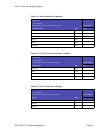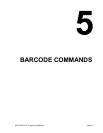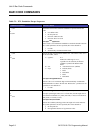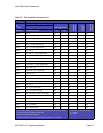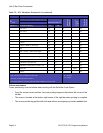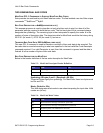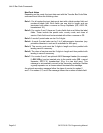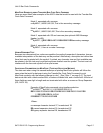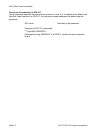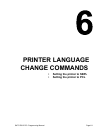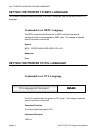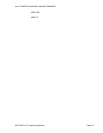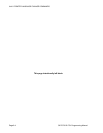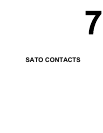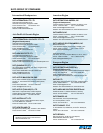Unit 5: Bar Code Commands
SATO D512 PCL Programming Manual Page 5-7
MAXICODE EXAMPLES USING TRANSFER BAR CODE DATA COMMAND
Here are some MaxiCode examples of the ASCII data that would be sent with the Transfer Bar
Code Data Command:
Mode 2, separated with commas:
ESC
&y48W1,1,40361,840,001,This is the secondary message.
Mode 3, separated with commas:
ESC
&y48W1,1,ABC01,840,001,This is the secondary message.
Mode 3, separated with GS and commas plus optional ANSI Message
Header (yy=99):
ESC
&y45W1,1,[)RS01GS99ABC01GS840GS022GSsecondary message
Mode 4, separated with commas:
ESC
&y28W1,1, Here is a mode 4 message
H
UMAN-READABLE TEXT
Because two-dimensional bar codes are capable of encoding thousands of characters, human-
readable interpretation of the data may not be practical. Alternatively, descriptive text rather than
literal text may be printed with the symbol. If printed, any character size and font available may
be selected, and the text may be printed anywhere desired near the symbol. The text must not
interfere with the bar code symbol or the quiet zones.
F
UNCTIONAL PARAMETERS FOR MAXICODE (TYPEFACE SELECTION METHOD)
The data sent when using this second technique of printing MaxiCode symbols will follow the
same rules that exist for data sent using the Transfer Bar Code Data Command to print
MaxiCode symbols, with the following change to rule 1. (See “Rule 1” on page 2-6.) The input
data must start with a label-number field, a number-of-labels field, and a mode field. All three of
these fields are one digit in length and are terminated with either a comma or Group Separator
(GS, ASCII 29).
Example of MaxiCode commands using typeface selection:
ESC
(s24800T
ESC
&p105X1,1,3,152382802,840,001,[)
RS01GS961Z00004951GSUPSNGS06X610GS159GS1234567GS
1/1GS10GSYGS634 ALPHA
DRGSGSPITTBURGHGSPARS
Where:
ESC
=escape character decimal 27, hexadecimal 1B
RS=record separator decimal 30, hexadecimal 1E
GS=group separator decimal 29, hexadecimal 1D



